How to connect a motion sensor to a light bulb: step-by-step instructions
Using a motion sensor to activate lighting when approaching a lamp significantly increases the level of comfort in your home/office/apartment.The miniature device manages the system for you, allowing you not to worry about such little things. Electricity consumption is reduced, and you can easily install it yourself.
It is worth getting a device that is economical in all aspects. Do you agree? We will tell you how to connect a motion sensor to a light bulb. The article we presented provides technological rules and diagrams available to a novice electrician. The placement options are listed and the specifics of the setup are described.
The content of the article:
Motion sensor: main functions and operating principle
The main purpose of the motion sensor is to switch the electrical network. It can work with both active load in the circuit and active-inductive load. Any movement in the controlled area first of all starts the process of determining the light level (if such a function is provided in the device).
If the indicator is below the set response threshold, the device closes the contacts and turns on the lamp. Thus, the detector can operate both at night and during the day. The response threshold is set using regulators; it can range from 3 to 2,000 Lux.
In everyday life, devices are most often installed whose operation is based on capturing electromagnetic oscillations of waves in the infrared spectrum.The time after which the detector is triggered if a moving object is detected is also adjustable.
By turning the knob, the shutter speed mode is set. For different models, the delay time can be adjusted from 10 s to 7-15 minutes (small error is allowed).
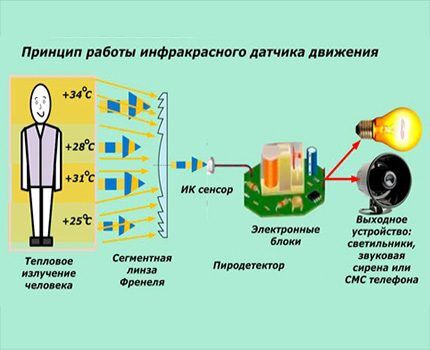
Guidelines for wise choice
Different models may have different purposes. Some are intended only for controlling indoor lighting devices, others are more versatile and can be used for circuits with electrical appliances, with alarm devices, with street lighting system.
Sensors can be with limited and all-round visibility, and have different horizontal and vertical viewing angles. Wall mounted devices control an area at an angle of 110-120° or 180° horizontally and 15-20° vertically.
Models with a movable viewing organ make setup much easier, but stationary ones do not have this option, so you need to choose the placement location for them more carefully.
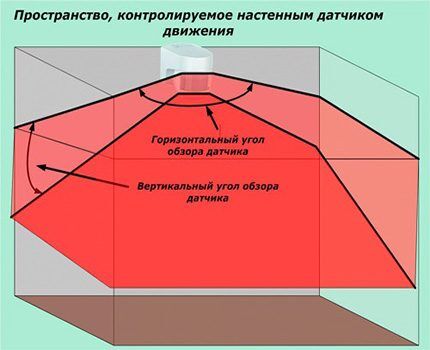
Detectors with all-round visibility can cover the controlled area at an angle of 360° horizontally. Their viewing area has the shape of a cone, expanding downwards. Despite the large control area, unseen areas (outside the radius, in the corners) in the room still remain.
To install the sensor outdoors or in rooms with high humidity, you must select a device with high degree of protection from external factors (dust, moisture).
For example, devices with a protective degree of IP20 can only be used in indoor areas with normal humidity; with IP33, they can be installed outdoors - on a terrace, porch, or gazebo. With IP44, you can install it outdoors, but protect it with a visor from drops of water during precipitation.
You can purchase a ready-made complex from switch and motion sensor. Our recommended article will introduce you to the features of its selection and installation.
Placement and orientation method
The general rules for installing sensors are as follows:
- the installation height above the observed surface can be from 2.5 to 4 m (the parameter depends on the device model);
- when choosing a mounting location, take into account that the detector is more sensitive to movement that occurs across the observation area;
- The total lamp load power is limited and can range, for example, from 60 to 1200 W for incandescent light bulbs and from 0 to 600 W for fluorescent illuminators.
Temperature also affects the sensitivity of the detector. The range of temperature values at which the device normally performs its functions is from -20 to 40 °C.
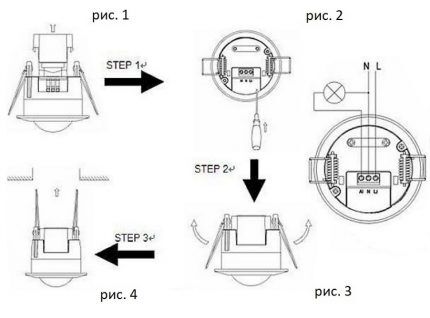
It is prohibited to install lamps:
- on vibrating surfaces;
- near fans, air conditioners;
- on glossy white wall surfaces;
- near heat sources - electric radiators, lamps;
- on surfaces exposed to direct sunlight.
To avoid false alarms, avoid exposing the infrared detector to sources of electromagnetic waves, wind and heat flows.
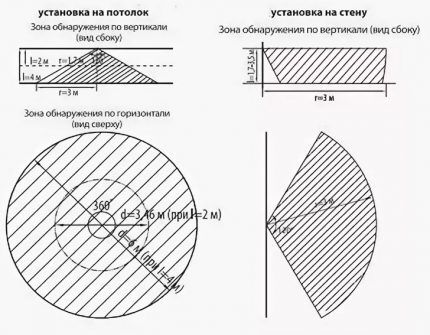
It is also impossible for incandescent lamp — a gradually cooling filament will trigger the detector, since it will respond by turning on to a change in its temperature.
This can continue indefinitely - the light will turn on and off. False alarms can also occur in windy weather due to swaying branches.

How to install the device and connect it to the lamp?
First, let's look at the installation of a motion sensor using the example of models that are installed in holes intended for spotlights.
The installation sequence is as follows:
- Turn off the power supply.
- Remove the protective plastic cover (Fig. 1).
- Connect the conductors (Fig. 2). The manufacturer indicates the connection diagram on the device itself and in the device passport.
- Bend the retaining springs, pointing them upward (Fig. 3).
- Install the sensor in the prepared hole (Fig. 4) - the springs will fix its position.
The installation can be considered complete. All that remains is to adjust and test the operation of the device.
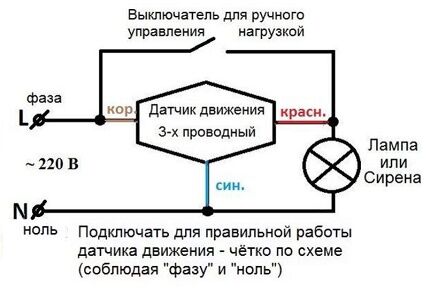
It is easier to install a sensor that is screwed into the cartridge. Then a light bulb is screwed into it. In this case, it is necessary to use only those lamps that are not more powerful than indicated in the device passport. It is advisable to purchase specialized lamps, designed to work in tandem with detectors.
To install a remote sensor in a ceiling, wall or lamp housing, you need to insert the device into the prepared hole and screw the housing to the mounting surface using self-tapping screws. Next, you need to turn off the network power and connect the phase and neutral conductors of the power cable to the terminals according to the diagram.
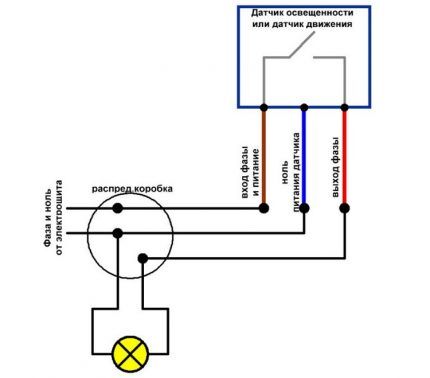
Testing and setting up the motion sensor
Each device has at least two regulators. Testing and adjustment is carried out according to two main parameters - the duration of the glow (TIME) and the sensitivity of operation (LUX). The first indicator means the period of time for which the sensor leaves the lamp on.
With each detected movement, the countdown of the duration of the glow begins again. It can be adjusted by the user for a period from 10 s to 4 min.
The sensitivity of the device is also an adjustable value. Using it, you can adjust at what level of natural light the light will turn on. Thus, you can set the lamp to turn on during the day and night, or only at night.
When putting a motion sensor into operation, it is subject to mandatory testing.To do this, set the light level regulator to a position that corresponds to daylight. The time control knob is set to minimum.
After connecting to the power supply, you need to wait about 30 seconds - the sensor will work and turn on the lighting for 30 seconds. Next, you should point the sensitive area of the sensor at the area that needs to be monitored, check the sensitivity and range.
Test whether the period of response and operation of the lamp corresponds to the set parameters. They also check the operation of the device at night and finally set parameters that are comfortable for themselves.
More complex devices that are used for security purposes also have a range regulator (SENS) in their design. It is used to set the sensitivity zone. The sensors are also equipped with a built-in microphone with a noise level control (MIC), at which the device should operate.
The last two regulators are rarely used for inexpensive sensors, since their functionality is rarely in demand in domestic conditions.
Options for connecting an IR device to a lamp
Using various connection schemes and additional devices, you can achieve wider functionality of the motion sensor. For example, expand the controlled area, disable automatic control of the lighting system or temporarily control the lighting group without the participation of a motion sensor, etc.
Connection for control without switch
The circuit consisting of a lamp and a detector is the simplest. It is printed on the back of the device by the manufacturer or is described in the attached instructions.
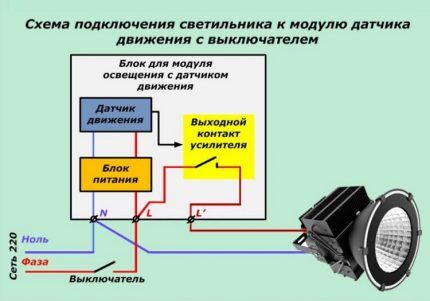
When arranging elongated rooms, along paths in the yard or along the perimeter of the building, one motion detection device is not enough to control the lighting - its limited visibility does not allow this.
In such cases, two or more detectors are used. Their terminals of the same name are connected in a parallel circuit and then lead to the lamp.
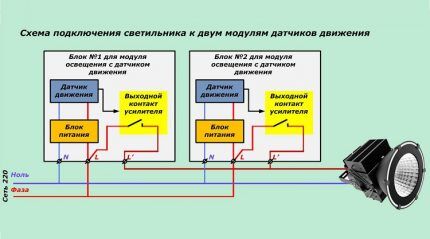
Connecting to a light bulb with a switch
To disable the automatic activation system, which operates based on a motion detector, a switch is added to the operating circuit. Connect it to the section of the incoming power cable in front of the sensor.
In the on position of the switch, the circuit operates in the same way as if it were made without it. When it is turned off, the motion sensor module is completely de-energized and the system does not work.
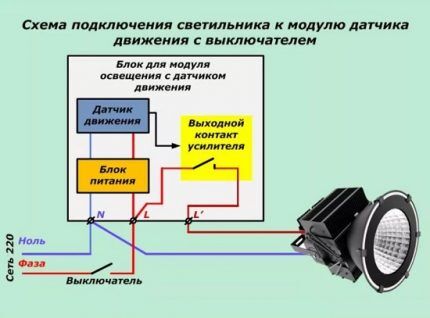
If it is necessary for the light to be on when a person is in the room, while being in a stationary position does not lead to the lighting being turned off, then use the following scheme.
A switch is connected to the input and output phase conductors of the sensor - thus creating a branch of the electrical network, bypassing the main section. Now, using a switch, you can turn on the lighting, which will not depend on physical activity in the controlled area.
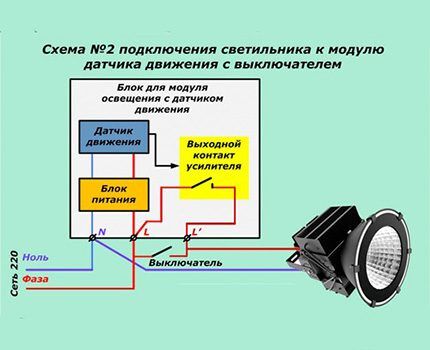
Field-tested wiring diagrams for a lighting control device using a switch are disassembled and are given in the article, which we highly recommend reading.
Conclusions and useful video on the topic
Video #1. How to connect a device using a simple scheme and configure it:
Video #2. Two options for connecting the sensor to a lamp with a switch:
The method of connecting the motion sensor to the lamp largely depends on the goals that you plan to achieve. Based on the need to organize automatic lighting in an apartment or on the street, near a protected building or garage, a device and operating diagram are selected.
Would you like to tell us how you connected a motion sensor to a light bulb with your own hands? Do you have useful information on a topic that can help site visitors? Please write comments in the form below, post photos in it and ask questions.




In principle, a very useful topic. Place a spotlight or lamp at the entrance. You connect it via a motion sensor, and it’s beautiful. I went out at night and it clicked and it turned on. Left, turned off. Comfortable. There are really two nuances. It is undesirable for the system to operate during the day; it would be better not to turn off while the object is in the field of view of the sensor. When choosing a sensor, it is necessary to take into account the possibility of such adjustment.
This is all regulated using modern motion sensors. However, from experience, adjusting the sensitivity level is not so easy.
Good day, Sergey. If you re-read the article, it turns out that the nuances you mentioned have been resolved long ago. When buying a sensor, you just need to make sure that there is a function for detecting “night” - insufficient lighting. She, the “function”, decides to turn on the light or not. If you bought it without it, and then realized it, it’s also not a big deal - install a key switch (you’ll turn it off during the day).
This site also offers another article - “Switch with a motion sensor: how to select and install a light switch with a sensor.” There you will read about the types of sensors - they respond to sound, infrared radiation, ultrasound, microwaves. Infrared, for example, will not turn off the light while a person is in the “zone”.
I have a question about these motion sensors for those who have already installed such houses: are there any problems with the setup? We just had a similar device in the entrance, often there were false alarms, or vice versa, a very slow response, when you already managed to walk a flight and only then the light came on. So they chased the electrician, he kept trying to adjust the sensitivity of the device normally. This would be an unpleasant situation for an apartment.
Good afternoon, Alexander. We installed infrared sensors with a coverage angle of 180 degrees - they work accurately. We took into account the experience of the neighboring house - there, while waiting for the elevator, you have to occasionally wave your hand for the light to turn on. Read the article on this site - “Motion sensor switch" The material contains answers to your questions.
The guys put one of these in the toilet. You walk in and the light turns on. Sat down on the potty - turns off. That's right, what is there to see there)))
Good afternoon, Egor.
Your comment about “Measure seven times...” - designers always have to draw up a “feasibility study.” There, the project customer is provided with a calculation of the payback time of the device, installation, or facility.
In relation to the toilet sensor, the situation will look like this:
- loss of electricity from a uselessly burning light bulb - ≤ 5% of the apartment’s electricity consumption;
— costs of purchasing and installing the sensor. To avoid annoying the device, you need to buy an expensive one. For example, a high-quality MTN564419 manufactured by Schneider Electric will cost RUB 25,000. Buy a Chinese one for 300 rubles, you will suffer.
Substitute the economic indicators of your case and it turns out that even an average-priced sensor will pay for itself in centuries.
For the sensor to work correctly:
1. It needs to be placed in the right place.
2. You need to know what type of collecting lens is installed.
3. And, in fact, understand the operating principles of this sensor in order to use it correctly.
By the way, recently sensors with 2 elements inside the sensor have gained popularity - it reacts to temperature changes between the elements, which occur sequentially when a person moves. But he also has his own drawback - if you stand still, then he does not see you :)
I just connected it... It’s not clear yet, I’ll have to check it during the day.